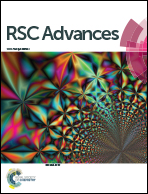A new detection mechanism involving keto–enol tautomerization: selective fluorescence detection of Al(iii) by dehydration of secondary alcohols in mixed DMSO/aqueous media†
Abstract
A new mechanism for the fluorescence detection of metal cations in solution is introduced involving a unique keto–enol tautomerization. Reduction of 1,8-anthraquinone-18-crown-5 yields the doubly reduced secondary alcohol, 2. Compound 2 acts as a chemodosimeter for Al(III) ions producing a strong blue emission due to the formation of the anthracene fluorophore, 3, via dehydration of the internal secondary alcohol in DMSO/aqueous solution. The enol form is not the most thermodynamically stable form under these conditions however and slowly converts to the keto form 4. Reduction of 1 with Fe/AcOH or the reaction of 2 with HCl directly yields compound 4, the keto tautomer of 3, which also produces the same blue emission in more polar solvents. Competition studies reveal that compound 2 produces a blue emission exclusively in the presence of the strong Lewis acidic Al(III) ion and at relatively low pH.


 Please wait while we load your content...
Please wait while we load your content...